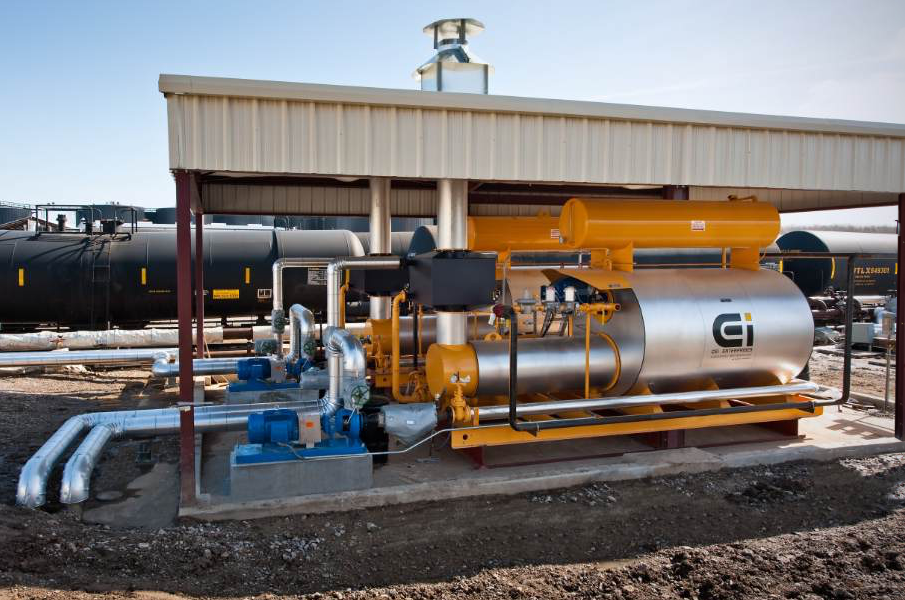Moving Liquid Around the Terminal
BY Michael Maddox

Asphalt storage terminals are tasked with moving massive amounts of liquid during any given operational period. Just like their end-user clientele, terminals must offload incoming stocks of liquid asphalt, meter and transfer it from storage to any production process (such as emulsion blending), and finally load out the end product into delivery vehicles. Just as with hot mix asphalt (HMA) plants, this involves storage, heating, piping and pumping systems. The logistics, however, are on a vastly different scale.
Consider a typically-sized HMA plant in a medium-sized city is likely to have one or two AC storage tanks, sized at 25,000 to 30,000 gallons each for a combined storage capacity of about 60,000 gallons. By comparison, even one small tank at a bulk storage terminal is likely to have a storage capacity of 70,000 barrels. With one barrel equaling 42 gallons, that’s 2.94 million gallons of liquid asphalt in one tank. Storage tanks of 120,000 barrels and even greater capacities are quite common.
The matter of filling these tanks is significantly different as well. Terminals require the ability to offload multiple rail cars at a time. A common rail car siding might include 10 cars, and a typical crude oil car has a capacity of approximately 680 to 720 barrels, (or 28,560 to 30,240 gallons). It can take from 97 to 102 rail cars to fill one 70,000 barrel tank.
Before the rail cars can be unloaded, they must be steam-heated to reduce the viscosity of the AC inside. Therefore, the terminal must be able to provide steam to the rail cars. This is typically done with a steam generator or with steam from a boiler, connected to the rail car by dedicated steam lines. Once asphalt in the rail cars is adequately heated, it is pumped out and transferred into storage tanks.

The difference in capacity between even a large HMA plant and a terminal is obvious. Terminals must have the ability to offload about 100 crude oil rail cars at a time with capacities of 680 to 720 barrels each to fill just one of the smaller tanks at the facility.
In many cases, terminals also require the ability to offload barges or tanker ships. Capacities of these vary widely, though it is common for inland river barges to have capacities from 10,000 to 30,000 barrels.
Barges typically provide their own heating to lower the viscosity of the AC. Most barges have an on-board thermal oil heater for this purpose. These heaters operate much like hot oil heaters at HMA plants, but at considerably higher outputs. Barge heaters of 8 million Btu/hour and higher outputs are common. Because the barge provides its own heating, the offloading lines at the terminal may require only electric trace heating.
Terminals, like asphalt plants and barges, must also have their own heating systems for the asphalt storage tanks and piping.
Though terminal sizes and their heating requirements vary widely, heaters at terminals are almost universally higher-output heaters than those on barges. Many terminals use twin thermal oil heaters that can be used individually or in tandem.
It is also common for terminals to use a combination of both thermal oil heaters and boilers.
For reasons of sheer economy, terminals typically maintain their stores of liquid asphalt at temperatures well below end-use temperatures. It is simply more cost-effective to store bulk quantities of asphalt at the minimum temperature required to pump it. That can be as low as 250 degrees F, though most terminals store it at slightly higher temperatures.
When end-users require the asphalt to be delivered at higher temperatures, the asphalt is routed through a booster heater before being loaded into tanker trucks for delivery. Booster heaters can come in the form of fired heaters or heat exchangers. In either case, the role of the booster heater is to rapidly boost the temperature of the asphalt as it flows from storage to the load-out rack.
Some load-out racks include systems that inject a small amount of silicone into the tanker right before the asphalt is loaded. This is to prevent the asphalt from foaming in the event that there is any water inside the tanker.
In addition to selling various performance-grade (PG) asphalts, many terminals also produce and sell asphalt emulsions. Asphalt emulsions are created by blending liquid asphalt with smaller percentages of water. Because these two substances naturally tend to separate, specialized equipment is needed to blend them together and store them. For this reason, it is common for a terminal to have an on-site emulsion blending plant.
The emulsion blending plant has its own dedicated tanks for asphalt, water, and any additional emulsifying agents used in the process. The liquid asphalt is passed through a colloid mill to shear it into smaller droplets that are able to blend more easily with the water. Due to the nature of water and asphalt to separate, storing emulsions poses an additional hurdle. To overcome this, additional chemical additives are injected to give the water and asphalt molecules an electrical charge… either all-negative (anionic emulsions), or all-positive (cationic emulsions). The like charges repel one another (as with two magnets), and this helps the emulsion remain in storage without separating prior to loadout.
As paving specs become more stringent in different parts of the country, terminals are providing a broader range of specialized products. In addition to various PG asphalts and asphalt emulsions, an increasing number of terminals are also producing polymer-modified and rubberized asphalts on-site.
